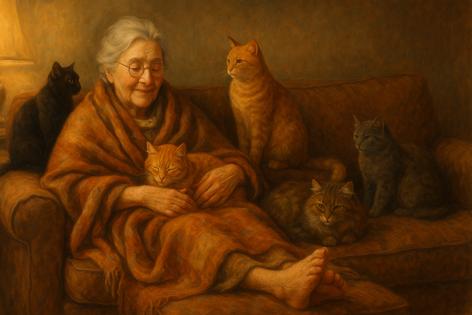Aging Gracefully: Caring for Your Senior Cat
Published in Cats & Dogs News
By the time a cat reaches 10 years of age, many owners begin to notice subtle changes. Slower movements, longer naps, and a certain contemplative look in the eyes all signal the passage from adulthood into the feline golden years. As more cats live well into their teens and even twenties thanks to advances in veterinary care and improved nutrition, understanding how to care for a senior cat has become increasingly important for pet owners.
Recognizing the Signs of Aging
Cats are famously good at hiding discomfort, so recognizing aging signs requires careful observation. Weight loss or gain, reduced grooming, clouded eyes, and decreased agility may all indicate age-related changes. Owners might notice their once-energetic pet hesitating before jumping or spending more time in secluded spots. Cognitive shifts can also occur, with some cats becoming disoriented or vocalizing more at night.
Dr. Linda Hsu, a feline veterinarian with over 20 years of experience, notes that changes in behavior can often be a senior cat’s only cry for help. “They may not limp or whimper the way a dog might. But if your cat suddenly starts urinating outside the litter box, it’s not mischief—it’s communication,” she says.
Routine Veterinary Care Is Crucial
Regular veterinary visits become increasingly important with age. While young cats can often go a year between checkups, senior cats should visit the vet at least twice annually. These visits help monitor for chronic conditions like kidney disease, hyperthyroidism, diabetes, arthritis, and dental problems, which are all more common in older felines.
Bloodwork, urinalysis, and dental exams can uncover early-stage issues before they become serious. “Preventive care is the cornerstone of senior pet health,” says Dr. Hsu. “A cat may appear perfectly healthy while quietly developing kidney disease. Early detection makes a real difference in how long and how well they live.”
Comfort and Accessibility at Home
As cats age, their needs shift in subtle but important ways. Owners can make small environmental adjustments that dramatically improve a senior cat’s quality of life. Soft bedding in warm, quiet corners helps with aging joints, and pet steps or ramps can restore access to a favorite windowsill or couch.
Older cats may have difficulty navigating stairs, jumping into litter boxes with high sides, or even reaching food dishes. “A low-sided litter box in a convenient spot can prevent accidents and stress,” says animal behaviorist Marina Alvarez. “It’s about preserving dignity and comfort.”
Diet and Hydration Needs Change
Senior cats often benefit from diets formulated specifically for their age group. These foods tend to have adjusted protein and phosphorus levels to support kidney health, and sometimes include added joint supplements. Maintaining a healthy weight becomes more important than ever, as both obesity and being underweight can lead to complications.
Hydration is especially critical. Cats are notoriously poor water drinkers, and older cats with kidney disease or other issues are particularly vulnerable to dehydration. Offering wet food, providing multiple fresh water sources, and experimenting with pet fountains can all encourage increased water intake.
Mental Stimulation and Emotional Support
While senior cats may not be as playful as kittens, they still benefit from mental enrichment and companionship. Interactive toys, scent games, and even clicker training can help keep their minds sharp. For some aging cats, the human bond becomes stronger, not weaker, as they slow down and seek out warmth and affection.
Some cats, however, become more irritable or withdrawn. Changes in sleep cycles, anxiety, and confusion are common signs of feline cognitive dysfunction, a condition similar to dementia in humans. “If your senior cat starts yowling at night or staring at walls, don’t just chalk it up to old age,” says Dr. Hsu. “There are medications and strategies that can help.”
Saying Goodbye with Compassion
No one likes to think about it, but the final chapter of a cat’s life is part of the journey. With attentive care, many cats enjoy their twilight years with grace and dignity. But when pain outweighs joy, or daily life becomes too burdensome, owners are faced with difficult choices.
Veterinary professionals encourage open conversations about end-of-life care well before crisis strikes. In-home hospice, pain management, and even in-home euthanasia services can offer peaceful alternatives when the time comes.
“I always tell people, your cat doesn’t fear death. They fear pain and loneliness,” says Alvarez. “So if you can give them comfort and presence, even at the end, that’s the last and most important gift.”
The Golden Years Can Shine
Caring for a senior cat is not a burden—it’s a privilege. These aging companions, with their slow blinks and quiet purrs, offer a different kind of connection than a playful kitten. They’ve shared couches, windowsills, and years of companionship. With patience, vigilance, and love, their golden years can truly shine.
As Dr. Hsu puts it, “They’ve given you their whole life. Giving them a soft landing is the least we can do.”
========
This article was created, in part, using AI tools.









Comments